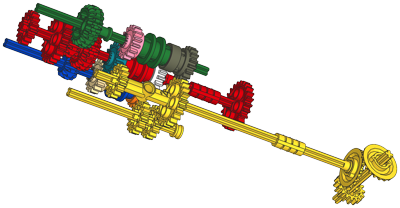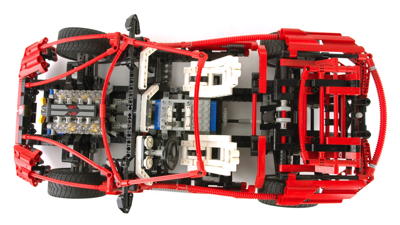Features
|
|
Complexity and Variability
This is an incredibly versatile model. The instructions first show
how to build the chassis which includes the gearbox, suspension, and
steering. Everything is modular with the frame, the engine, the
front suspension, the rear suspension, and the transmission all being
separate modules. The engine can be mounted in either the front or
the rear with no change to functionality. Then the instructions
continue with body options. The convertible and gull-wing options
are fully defined in the instructions, with partial instructions for
four other possibilities. After that, a motor can be added to more
fully realize the utility of the gearbox or, for the truly adventurous,
a Mindstorms RCX can be added for remote control.
|


 
|
|
Steering
The front wheels are steerable with a rack and pinion system. This
is one of the very few not only to have the steering wheel usable, but
to NOT have a "hand of god" control for easy play.
Rack and pinion steering doesn't get much simpler than this. The
steering wheel is connected to the pinion via a couple of universal
joints. The rack is connected to tie rods going out to the
steering knuckles. A second pinion is used just to hold down the long rack.
Note that these steering knuckles do NOT include Ackerman
correction. This is a bit surprising given the otherwise complex
model and the fact that there is plenty of room inside the deep wheels.
|


Click for an animation of the
steering in motion.
|
|
Engine
This set features a front mounted V-8 engine. The engine is made from cylindrical engine elements
and is driven by the rear wheels.
The crankshaft is
offset 1/2 stud from center, giving the pistons a stroke of 1
stud. The crank has 4 crank pins at 180 degree angles. Most
V-8s have crossplane cranks with the pins at 90 degrees. While
many racing V-8s do indeed have flatplane cranks like this LEGO
version, they are always 0-180-180-0 instead of 0-180-0-180.
The engine also has a number of aesthetic features such as an intake
manifold and a 3 blade fan.
The modular engine can be removed from the front and installed in the
back instead, but only when the model is built in gull-wing mode.
The whole process takes only a few seconds.
|



Click for an animation of the
engine
in motion.
|
|
Transmission
The transmission is located between the seats. As a synchronized unit, this
one does not need to be aligned to shift and can even be shifted while
rotating.
The photograph shows the shift lever and gate with the 6
positions. As the lever is moved through the H-shaped gate, one of the three driving rings is forced into position.
Note that only one driving ring can be engaged at a time. Passing
through the center of the H returns the opposite ring to center.
The driving ring is the key to everything. It slides over the
ridged axle joiner
which we first saw in 1993. Small tabs on the driving ring allow
it to lock along these ridges, but still slide with some extra
force. The driving ring grips the longitudinal grooves on the
axle joiner causing them to rotate together. A circumferential
groove in the middle of the ring allows it to be pushed along the axle
joiner in either direction. A set of 4 driving dogs on either end
then mate with a 16 tooth idler gear allowing the idler's rotation to
be either synched with the axle or allowed to spin freely.
The animation shows how the driving rings work to engage and
disengage the clutch/idler gears. The driving ring is shown in
red. The
lower axles are joined with the gray axle joiner. The driving
ring rotates with the axles. At first, the driving ring is
disengaged so both the dark gray and green gears are not driven and
slip on the axle. The driving ring then engages the green gear
and
thus drives the blue gear. Because the driving ring does not use
gear teeth but
rather uses four tapered driving dogs, there is considerable backlash
between the driving ring and the gear. The allows the driving
ring to be engaged even while it and the mating idler gear are turning
at different speeds.
The computer images are coded to show the different
gears paths for each of the 6 gears. The red parts go to the
engine (front or back mounted). The yellow differential is the output to the
wheels. You can see that the red axles interface with
the other gears in two places: blue and green. This means that
the red, blue, and green axles are always turning at different rates. Now let's trace each of the 4 gears
starting always with the red engine axle:
- 1st Gear: (green ring, pink gear) 20:12
(green) x 16:16 (pink) x 16:16 (turquoise) x 20:20 (bevels)
x 16:24 (final diff) = 1.11:1.
- 2nd Gear: (red ring, white gear) 16:16
(white) x 16:16 (orange) x 24:16 (yellow) x 20:20 (bevels)
x 16:24 (final diff) = 1:1.
- 3rd Gear: (red ring, turquoise gear) 16:16 (turquoise) x 20:20 (bevels)
x 16:24 (final diff) = 0.67:1.
- 4th Gear: (blue ring, orange gear) 12:20 (blue) x 16:16 (orange) x 24:16 (yellow) x 20:20 (bevels)
x 16:24 (final diff) = 0.6:1.
- 5th Gear: (blue ring, tan gear) 12:20 (blue) x 16:16 (tan) x 16:16 (turquoise) x 20:20 (bevels)
x 16:24 (final diff) = 0.4:1.
- Reverse: (green ring, dark gray gear) 20:12
(green) x 24:16 (dark gray) x 20:20 (bevels)
x 16:16 (final diff) = -2.5:1.
|
|
|
Suspension
All 4 wheels have independent suspension.
Front suspension is a standard double wishbone type. The unique
steering knuckle with upper and lower ball joints as well as the tie rod
joint is used. It was never used again. Because it is a
four bar linkage, the wheel stays perpendicular to the ground
throughout its travel. A pair of shock absorbers provide
support.
The rear suspension is also a double wishbone type, but because it is
unsteered ball joints are not needed so standard liftarms are used
instead of control arms.
The suspension on this model is quite soft compared to other
supercars. The front suspension depresses about half way under the
weight of the model, which is exactly as it should be. This means
the shocks can both extend or compress from neutral.
|

 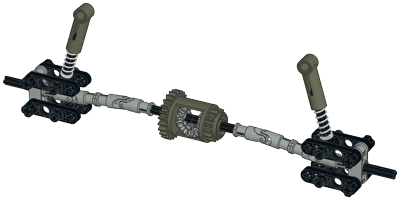
Click for an animation of the
front suspension
in motion.
|
|
Differential
This set uses a differential gear on the rear axle. It
incorporates a built in 16 and 24 tooth ring gear, either of which work as a spur.
In this case the larger 24 tooth is used. The differential is made
to house 3 of the 12 tooth bevel gears. One is on each axle,
and one planet gear in the middle allows the axles to turn at different
rates.
|
 
Click for an animation of a
differential
in motion.
|
|
Convertible Top
The convertible top uses a clever mechanism which is powered by one of
the new dampers. The gray ball joint shown in the computer image
is the trigger. Pushing this down lift the pair of black steering
arms, thereby lifting the 6x4 bent liftarms. This drives the cams
attached to the damper over center. Once this point is crossed,
the spring slowly lifts the roof into position. The roof mechanism
itself is a 4-bar linkage which keeps it parallel to the ground.
Both the up and down locked positions line up perfectly with the car.
I prefer the car in convertible mode because in gull-wing mode the back
looks too empty. Additionally, I prefer the top down.
|
 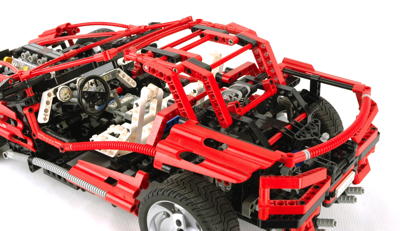

Click for an animation of the top
opening.
|
|
Gull Wing Doors
The convertible top mechanism can be removed and converted to a pair of
gull-wing doors. In this mode, a ball joint on each side is used
as a trigger. Pushing the ball down turns a vertical crank (shown
in gray). The crank pushes the axle (shown in red) into the
damper, forcing it over center. At this point, the spring slowly
lifts the door.
This mode uses many more parts than the convertible mode, nearly all the
parts in the set. In the convertible mode there are a lot of
spare parts. There are not enough parts to build modules for both modes at the same time.
|
|
|
Motorization
The model includes a set of yellow jack stands which can be used to lift
the rear wheels off the ground. When used in combination with a
motor (available as a supplemental set), this allows the user watch the
engine turn at a constant while the rear wheels change speed as you run
through the gears.
When the model is in gull-wing mode, the space in the rear is just the
right size for a Mindstorms RCX. Three motors can be added: two
for drive and one for steering. With the addition of an RCX
remote, this was the very first wireless, remote controlled Technic model.
|
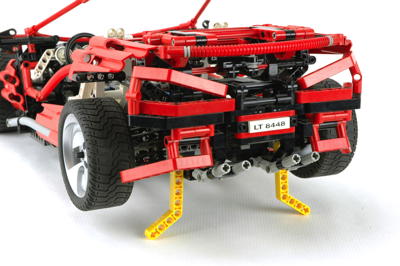  |
|
Wheels and Tires
Both the wheels and tires are unique to this model. The wheels are
metallic silver and have a large offset with a lot open space inside
the dish. This allows the steering axis to be near the center of
the wheel. This is the only Technic model with such
geometry. The pattern on the wheels is directional, so it looks
like it is rotating the wrong direction on one side of the car.
The tires are 81.6x34 ZR with a unique tread pattern. They are the same diameter and width and the tires of 8880 but lower profile.
|

|















